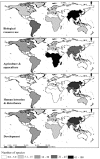Quantifying anthropogenic threats to orchids using the IUCN Red List
- PMID: 29043611
- PMCID: PMC5857263
- DOI: 10.1007/s13280-017-0964-0
Quantifying anthropogenic threats to orchids using the IUCN Red List
Abstract
Orchids are diverse, occur in a wide range of habitats and dominate threatened species lists, but which orchids are threatened, where and by what? Using the International Union for Conservation of Nature Red List, we assessed the range and diversity of threats to orchids globally including identifying four threat syndromes: (1) terrestrial orchids in forests that are endemic to a country and threatened by illegal collecting; (2) orchids threatened by climate change, pollution, transportation and disturbance/development for tourism, and recreation activities, often in East Asia; (3) epiphytic orchids in Sub-Saharan Africa including Madagascar with diverse threats; and (4) South and Southeast Asia orchids threatened by land clearing for shifting agriculture. Despite limitations in the Red List data, the results highlight how conservation efforts can focus on clusters of co-occurring threats in regions while remaining aware of the trifecta of broad threats from plant collecting, land clearing and climate change.
Keywords: Conservation; Global biodiversity; Human impacts; Illegal plant collection; Threatened species.
Figures





Similar articles
-
Tourism and recreation listed as a threat for a wide diversity of vascular plants: a continental scale review.J Environ Manage. 2015 May 1;154:293-8. doi: 10.1016/j.jenvman.2014.10.035. Epub 2015 Mar 6. J Environ Manage. 2015. PMID: 25748596
-
Orchid conservation and research: An analysis of gaps and priorities for globally Red Listed species.Ambio. 2020 Oct;49(10):1601-1611. doi: 10.1007/s13280-019-01306-7. Epub 2020 Jan 20. Ambio. 2020. PMID: 31960279 Free PMC article. Review.
-
Agroecosystems and primate conservation in the tropics: a review.Am J Primatol. 2012 Aug;74(8):696-711. doi: 10.1002/ajp.22033. Epub 2012 May 17. Am J Primatol. 2012. PMID: 22605526 Review.
-
Patterns and biases of climate change threats in the IUCN Red List.Conserv Biol. 2018 Feb;32(1):135-147. doi: 10.1111/cobi.13022. Epub 2017 Oct 12. Conserv Biol. 2018. PMID: 28861903
-
Extinction risks and the conservation of Madagascar's reptiles.PLoS One. 2014 Aug 11;9(8):e100173. doi: 10.1371/journal.pone.0100173. eCollection 2014. PLoS One. 2014. PMID: 25111137 Free PMC article.
Cited by
-
Orchid Micropropagation Using Conventional Semi-Solid and Temporary Immersion Systems: A Review.Plants (Basel). 2023 Mar 2;12(5):1136. doi: 10.3390/plants12051136. Plants (Basel). 2023. PMID: 36904000 Free PMC article. Review.
-
The effect of global warming on the Australian endemic orchid Cryptostylis leptochila and its pollinator.PLoS One. 2023 Jan 30;18(1):e0280922. doi: 10.1371/journal.pone.0280922. eCollection 2023. PLoS One. 2023. PMID: 36716308 Free PMC article.
-
How Effective Is Environmental Protection for Ensuring the Vitality of Wild Orchid Species? A Case Study of a Protected Area in Italy.Plants (Basel). 2024 Feb 23;13(5):610. doi: 10.3390/plants13050610. Plants (Basel). 2024. PMID: 38475457 Free PMC article.
-
Forest Orchids under Future Climate Scenarios: Habitat Suitability Modelling to Inform Conservation Strategies.Plants (Basel). 2024 Jun 30;13(13):1810. doi: 10.3390/plants13131810. Plants (Basel). 2024. PMID: 38999650 Free PMC article.
-
Species life-history strategies affect population responses to temperature and land-cover changes.Glob Chang Biol. 2023 Jan;29(1):97-109. doi: 10.1111/gcb.16454. Epub 2022 Oct 17. Glob Chang Biol. 2023. PMID: 36250232 Free PMC article.
References
-
- Adhikari YP, Fischer HS, Fischer A. Host tree utilization by epiphytic orchids in different land-use intensities in Kathmandu Valley, Nepal. Plant Ecology. 2012;213:1393–1412. doi: 10.1007/s11258-012-0099-0. - DOI
-
- Australian Government . Species listed under the Environment Protection and Biodiversity Conservation Act 1999 (EPBC Act) Canberra: Australian Government; 2016.
-
- Ballantyne M, Pickering C. Ecotourism as a threatening process for wild orchids. Journal of Ecotourism. 2012;11:34–47. doi: 10.1080/14724049.2011.628398. - DOI
-
- Brundrett MC. Scientific approaches to Australian temperate terrestrial orchid conservation. Australian Journal of Botany. 2007;55:293–307. doi: 10.1071/BT06131. - DOI
MeSH terms
LinkOut - more resources
Full Text Sources
Other Literature Sources

